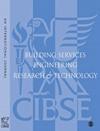Artificial neural network modelling for predicting classical air pressure profile curves in building drainage systems
IF 1.8
4区 工程技术
Q3 CONSTRUCTION & BUILDING TECHNOLOGY
Building Services Engineering Research & Technology
Pub Date : 2023-06-02
DOI:10.1177/01436244231180600
引用次数: 0
Abstract
Water trap seal loss can lead to the ingress of foul odours from the sewer network carrying harmful pathogens which can affect the health of building occupants. This loss is due to excessive negative or positive pressures within the system as a consequence of rapidly changing flow due to the unsteady nature of air and water flow discharges from appliances. This pressure regime within the system is often represented by a pressure profile along the height of the main vertical stack in the Building Drainage System (BDS). Experimental data from peer-reviewed literature and data from a unique 34-storey drainage test rig have been used as pressure profile data (Test data) for an Artificial Neural Network (ANN) model. Discharge input height (storey number) and discharge flow rate are considered to be the two independent input parameters and the pressure along the vertical stack is considered to be the output. In this work, both a Feed Forward and Back Propagation (FFBP) ANN model and a Radial Basis Function (RBF) ANN model have been used to train the algorithm. The work has confirmed the applicability of the FFBP-ANN model for steady two-phase fluid flow phenomena in BDS and allows for the prediction of pressures in a system for which no pressure data exists, by the prediction of modelled weights, based only on its physical and flow characteristics. Practical Application: Of great concern to designers of building drainage systems (BDS) is the control of pressure fluctuations within the system to prevent water trap seal loss. Prediction of a pressure profile based on the characteristics of the building – e.g. height, location of water discharge, discharge flow rate and ventilation type, would therefore increase confidence in designs, particularly in tall buildings. The work presented here addresses, for the first time, the applications of two ANN models for predicting the pressure profile in the BDS vertical stack of multi-storey buildings.人工神经网络模型用于预测建筑排水系统中的经典气压剖面曲线
脱水器密封损失会导致下水道网络中携带有害病原体的恶臭进入,从而影响建筑物居住者的健康。这种损失是由于系统内的负压或正压过大,这是由于设备排出的空气和水流的不稳定性质导致流量快速变化的结果。系统内的这种压力状态通常由建筑物排水系统(BDS)中沿主垂直烟囱高度的压力剖面表示。来自同行评审文献的实验数据和来自独特的34层排水试验台的数据已被用作人工神经网络(ANN)模型的压力剖面数据(试验数据)。排放输入高度(层数)和排放流量被认为是两个独立的输入参数,沿垂直烟囱的压力被认为是输出。在这项工作中,前馈和反向传播(FFBP)人工神经网络模型和径向基函数(RBF)人工神经模型都被用来训练算法。这项工作已经证实了FFBP-ANN模型对BDS中稳定两相流体流动现象的适用性,并允许通过仅基于其物理和流动特性预测建模权重来预测不存在压力数据的系统中的压力。实际应用:建筑排水系统(BDS)的设计者非常关心的是控制系统内的压力波动,以防止脱水器密封损失。因此,根据建筑物的特征(如高度、排水位置、排水流速和通风类型)预测压力剖面将提高设计的信心,尤其是在高层建筑中。本文首次介绍了两个人工神经网络模型在预测多层建筑BDS垂直烟囱压力剖面中的应用。
本文章由计算机程序翻译,如有差异,请以英文原文为准。
求助全文
约1分钟内获得全文
求助全文
来源期刊

Building Services Engineering Research & Technology
工程技术-结构与建筑技术
CiteScore
4.30
自引率
5.90%
发文量
38
审稿时长
>12 weeks
期刊介绍:
Building Services Engineering Research & Technology is one of the foremost, international peer reviewed journals that publishes the highest quality original research relevant to today’s Built Environment. Published in conjunction with CIBSE, this impressive journal reports on the latest research providing you with an invaluable guide to recent developments in the field.
 求助内容:
求助内容: 应助结果提醒方式:
应助结果提醒方式:


